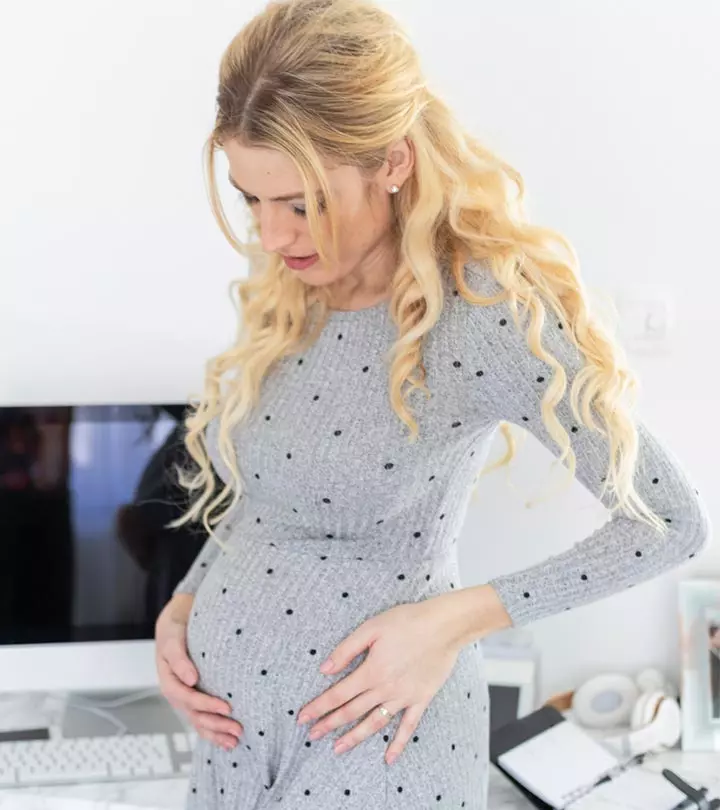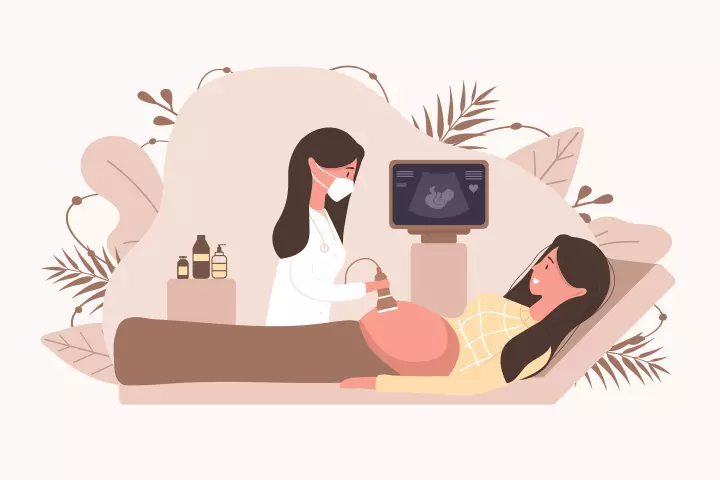
Image: iStock
Ovary pain during pregnancy can be due to several underlying conditions and often manifests as pelvic or abdominal pain. According to the American Pregnancy Association (APA), cramping is common during the early stages of pregnancy, especially in the first trimester, as your body adjusts to the changes (1). Irrespective of the symptoms and the trimester, consult your healthcare provider if you experience severe abdominal pain, specifically in the pelvic region, to rule out underlying morbidities. This post will guide you through the causes, symptoms, diagnosis, and treatment of ovary pains during pregnancy.

Key Pointers
- Ovarian pain can indicate implantation if it arises from ovarian cysts that are common during early pregnancy.
- However, ovarian pain can also occur due to ectopic pregnancy, stretching of the round ligament, UTIs, gallbladder problems, or placental abruption.
- Medical intervention is necessary if ovarian pain is accompanied by additional symptoms, such as fever with chills, spotting/bleeding, and vomiting/nausea.
- Cultures, blood tests, pelvic laparoscopy, MRI, and CT scans are some diagnostic tools the doctor may use to determine ovarian pain’s cause.
- If the doctor rules out any complications, prenatal yoga, optimal water intake, ample rest, and frequent position change could help manage pain at home.
Is Ovary Pain A Sign Of Implantation?

Ovarian pain can be a sign of implantationiProcess by which the embryo (after fertilization) attaches to the uterine wall if it arises from ovarian cysts (corpus luteumiA temporary endocrine gland that plays an essential role in ovulation and early pregnancy. cyst), which are common during pregnancy and help sustain it (2). This type of pain may also be accompanied by implantation bleeding. However, ovarian pain can also indicate an ectopic pregnancy, where the egg implants outside the uterus, such as in the fallopian tubesiMuscular, hollow ducts connecting the uterus with the ovaries to transport eggs during ovulation. or ovary (3) . Therefore, any stomach discomfort or abdominal pain during pregnancy should be reported to your healthcare provider.
What Are The Causes Of Ovarian Pain?
Although ovarian pain is common in pregnancy, its causes can vary and, sometimes, lead to other reproductive health conditions. The causes of ovarian pain include
- Stretching of round ligament: During the second trimester of gestationiTime spent in the uterus from conception to birth of the baby , as the uterus begins to grow, the round ligaments that support the uterus stretch, causing cramping in the lower abdomen. The round ligaments are located on the sides of the uterus. The intensity of round ligament pain may range from acute to mild pain (4).
- Accommodation changes: As the pregnancy progresses, you may experience pain in the pelvic region or ovaries as your body stretches or loosens the pelvic bones to accommodate the growing uterus and prepare for childbirth (5).

- Ectopic pregnancy: In this type of pregnancy, implantation occurs outside the uterus, mostly in the fallopian tube. Since the fallopian tubes are not meant to hold an embryo, complications arise, such as pain on either side of the uterus.
You may experience symptoms such as bleeding as the pregnancy progresses and should consult your healthcare provider (6).
- Miscarriage: Miscarriage or spontaneous abortioniA natural loss of pregnancy before 20 weeks of gestation. is the loss of pregnancy due to abnormalities of the chromosomes, thyroid disorder, high sugar levels, etc., and can cause pelvic or ovarian pain.
Prenatal care is crucial to reduce the risk of miscarriage. Eight out of ten miscarriages occur in the first three months of pregnancy and are present with bleeding, lower back pain, lower abdominal pain, and cramps (6).
- Ovarian rupture and torsion: This is among the most common causes of ovarian pain. According to a study, pregnant women are at a higher risk of ovarian torsion, with 10–25% of cases occurring during pregnancy, most commonly during the third trimester (19). Growing functional ovarian cysts can sometimes rupture, causing pain and bleeding in the ovaries. The weight of the ovarian cysts can also cause the ovaries to twist on the tissues surrounding them or the fallopian tubes, causing severe ovarian pain (6).
Recalling her diagnosis of an ovarian cyst during the first trimester of her pregnancy, Rufiio, a vlogger, says, “During weeks five and six, I suddenly developed stomach discomfort, bloating, and constipation. I had my first ultrasound and then I also had a doctor’s appointment. My doctor told me after the ultrasound that the baby was healthy, however they found a complicated cyst.
“The cyst was about 5.4 centimeters. The doctor said she would check if it was getting bigger, smaller, or staying the same. I might have needed surgery in my second trimester if it’s an emergency. If not, my doctor said we can wait until after the baby is born (i).”
 Quick fact
Quick fact- Appendicitis: The growing uterus leads to the appendixiA hollow organ present in the lower abdomen, attached to the large intestine shifting higher in the abdomen naturally in every pregnant woman, making the diagnosis of appendicitisiA medical emergency identified by severe pain due to an inflamed or infected appendix. difficult. It requires prompt treatment and surgery if suggested (7).
- Gallbladder problems: During pregnancy, hormonal changes can lead to gallbladderiA small pear-shaped internal organ located in the upper right abdomen that stores bile problems. Elevated hormone levels that may slow down or stop bile flow from the gallbladder, causing the bile to harden and resulting in gallbladder stones. Clinical manifestations may include itchiness, vomiting, jaundice, and severe pain in the abdomen (8).
- Urinary tract infection (UTI): Pregnancy makes women more prone to UTIs since the increasing size and weight of the uterus, which is directly above the bladder, can block the flow of urine from the bladder. Common symptoms include a burning sensation while peeing, pain in the bladder or lower abdomen, and blood in the urine (9).
 Quick tip
Quick tip- Fibroids: These are benign tumors of the uterus. They cause severe lower abdominal pain, which could indicate enlargement of the fibroidsiNon-cancerous tumors that are formed in or on the wall of the uterus. and cause fertility issues such as miscarriage, premature birthiThe delivery before the completion of 37th weeks of gestation , and problems in implantationiAn early stage in fertilization when cells attach to the uterine wall (10). According to the UT Southwestern Medical Center, approximately 76% of fibroids shrink after childbirth, with 36% of those diagnosed in early pregnancy resolving on their own.

- Kidney stones: The tendency to urinate frequently in pregnancy could make you drink less water. Dehydration may cause kidney stones. Common symptoms include blood in the urine, vomiting, and dizzinessiFeeling lightheaded, weak, or unstable (11).
- Placental abruption: This refers to the detachment of the placentaiA temporary organ formed in pregnancy that clings to the uterus and supplies nutrients and oxygen to the developing fetus from the uterus before delivery. Placental abruption can be fatal and causes acute stomach pain and hardening of the stomach for long durations (4).
- Preeclampsia: It is a pregnancy condition characterized by high blood pressure and protein in the urine, causing vomiting, nausea, and abdominal pressure (4).
- Ovarian cancer: This is a rare phenomenon; usually, an ovarian mass or tumor is found during the early stage of pregnancy. However, with proper treatment, one can have a healthy pregnancy. Typical symptoms include pain in the lower abdomen, bloating, and fatigue (12).
- Pelvic inflammatory disease (PID): This condition affects the ovaries, fallopian tubes and the uterus. It is usually caused by untreated sexually transmitted infections (STIs). Symptoms include pain in the lower abdomen, chills, and fever. Antibiotics and IV medication are generally used to treat PID (13).
How Is Ovarian Pain Diagnosed?

The diagnosis for ovarian pain largely depends on the symptoms and causes and is made using the following diagnostic tools (14) (15):
- Lab and blood tests: Vaginal swabs for bacterial culture and blood tests for white blood cell count may be carried out to detect any signs of the infection causing pelvic and ovarian pain.
- Imaging: The most common imaging modality is an ultrasound scan, which helps visualize the abdominal and pelvic region. Your healthcare provider may also suggest an MRI, depending on the symptoms. This is particularly useful in detecting the root cause of pelvic pain.
- Diagnostic laparoscopy: It may be performed for better visualization. A small cut is made in the abdomen and a tube fitted with a camera is inserted for either tissue extraction or surgery, depending on the type and cause of pain.
- Differential diagnosis: An ultrasound scan is the first diagnostic tool utilized for most of the above-mentioned causes of ovarian pain. However, there are some exceptions.
- For UTI and kidney stone-related pain, urine analysis is carried out to test for UTI-causing bacteria.
- For pain caused by an ectopic pregnancy, ovarian cyst rupture, or torsion, a pelvic examination, such as pelvic ultrasound and diagnostic laparoscopy.
When Should You Seek Help?
Ovarian pain during pregnancy may suggest underlying complications if accompanied by severe or persistent symptoms. Hence, contact your healthcare provider if any of the following symptoms arise (4):
- Vomiting or nausea
- Vaginal discharge, bleeding, or spotting
- Fever with chills
- Persistent pains for long durations
- Dizziness
- Pain accompanied by breathing difficulty
Can Ovarian Pain Be Managed At Home?

You could try these home remedies for ovary pain if your healthcare provider rules out any complications (6):
- Simple stretching exercises
- Prenatal yoga and meditation
- Sufficient water intake
- Warm compress
- Reducing intense physical activity
- Ample rest
- Sitting with your knees close to the chest to minimize pressure
- Shifting positions often
What Are The Treatments For Ovarian Pain?
The treatments for ovarian pain may depend on the cause and symptoms of the pain.
- Medication: The medication prescribed would primarily depend on the cause and severity of the pain. Your gynecologist may prescribe certain pain relief medications for pain control during further investigations (7) (8) (11). For ectopic pregnancy, methotrexate may be injected into the body (3).
Note: You can take medications only after consultation with your healthcare provider. - Surgery: Ovarian pain due to ectopic pregnancy requires immediate surgery. In case of ovarian torsion, laparoscopic surgery or laparotomy may be performed. Cystoscopy may be carried out for kidney stones that do not dissolve naturally or with medication (6) (11).
Frequently Asked Questions
1. Where do I feel ovarian pain?
You may experience pain in the lower back or abdominal region. In most women, a dull or sudden pain during ovulationiA phase during the menstrual cycle where a mature egg releases from the ovary is felt in either the right or left of your abdomen. The pain usually lasts anywhere from a few minutes to one to two days (16)
2. Will ovary pain in pregnancy go away on its own?
Ovarian pain due to less-severe reasons in pregnancy may resolve spontaneously. Usually, ovarian pain caused by a ruptured cyst needs treatment. Otherwise, for small ovarian cysts during pregnancy, medical intervention is generally not required, as they often go away by the second trimester (17).
3. Can ovary issues cause miscarriage?
Dr. Alan Lindemann, MD, an obstetrician, maternal mortality expert, and former clinical associate professor at the University of North Dakota, says, “While it is unlikely for ovarian tissue to cause a miscarriage, it is possible that eggs are not being appropriately released or that the lining of the uterus is not appropriately supported by ovarian hormones.”
4. Can ovary pain affect my baby?
Mild ovarian discomfort, like pelvic or abdominal pain, typically doesn’t harm the baby. However, if the pain gets worse or is accompanied by symptoms like vaginal bleeding, intense pain, or a high fever, it’s essential to see a doctor. These could be signs of serious pregnancy-related issues that need medical attention (3).
Mild ovarian pain in early pregnancy, which is manageable, is not uncommon as your body adjusts to the new changes. However, it would help if you did not ignore recurrent or severe pain, especially when accompanied by other symptoms, including bleeding, fever, and fatigue. These signs could indicate more severe problems such as spontaneous abortion, ectopic pregnancy, ovarian cyst, and preeclampsia. However, you can contact your healthcare provider for timely diagnosis and interventions to avoid any risks of complications caused due to ovarian pain during pregnancy.
Infographic: Conditions Leading To Pain In The Ovaries During Pregnancy
Ovarian pain in pregnancy can occur from either common changes such as stretching of the uterus or an underlying condition such as torsion or a rupture requiring immediate medical attention. This infographic will help you understand the different causes in a simpler and concise manner.
Some thing wrong with infographic shortcode. please verify shortcode syntax
Some thing wrong with illustration image shortcode. please verify shortcode syntax
Pelvic pain in early pregnancy can be overwhelming. Learn about the symptoms, causes, and tips for relief in this informative video.
Personal Experience: Source
MomJunction articles include first-hand experiences to provide you with better insights through real-life narratives. Here are the sources of personal accounts referenced in this article.
i. Pregnant With A Complex Ovarian Cyst | Week 5-8;https://www.youtube.com/watch?v=R6vuzuxPUeg
References
- Pregnancy Cramps.
https://americanpregnancy.org/healthy-pregnancy/pregnancy-concerns/cramping-during-pregnancy/ - Ovarian cysts.
https://womenshealth.gov/a-z-topics/ovarian-cysts - Ectopic Pregnancy.
https://my.clevelandclinic.org/health/diseases/9687-ectopic-pregnancy - Stomach Pain in Pregnancy.
https://americanpregnancy.org/healthy-pregnancy/pregnancy-complications/abdominal-pain-during-pregnancy/ - Pregnancy: Pelvic and Hip Pain.
https://www.lancastergeneralhealth.org/healthwise-library/healthwise-article?documentId=tn9115 - Uterus Pain: Learn About The Causes and Treatment In Early Pregnancy.
https://www.medanta.org/patient-education-blog/what-causes-uterus-pain-in-early-pregnancy - Gad Aptilon Duque and Stephen Mohney; (2025); Appendicitis in Pregnancy.
https://www.ncbi.nlm.nih.gov/books/NBK551642/ - Abdominal Pain in Pregnancy Gallstones.
https://mountnittany.org/news-stories/health-and-wellness/ - Urinary Tract Infection During Pregnancy.
https://americanpregnancy.org/healthy-pregnancy/pregnancy-complications/urinary-tract-infections-during-pregnancy/ - Fibroids and Fertility.
https://www.reproductivefacts.org/news-and-publications/patient-fact-sheets-and-booklets/documents/fact-sheets-and-info-booklets/fibroids-and-fertility/ - Pregnancy and Kidney Stones.
https://www.urologyhealth.org/healthy-living/urologyhealth-extra/magazine-archives/summer-2019/did-you-know-pregnancy-and-kidney-stones - Ovarian Cancer During Pregnancy.
https://americanpregnancy.org/healthy-pregnancy/pregnancy-complications/ovarian-cancer-during-pregnancy/ - Pelvic Inflammatory Disease.
https://my.clevelandclinic.org/health/diseases/9129-pelvic-inflammatory-disease-pid - Sarah L. Cartwright and Mark P. Knudson; (2008); Evaluation of Acute Abdominal Pain in Adults.
https://www.aafp.org/pubs/afp/issues/2008/0401/p971.html - Pelvic Pain.
https://my.clevelandclinic.org/health/symptoms/12106-pelvic-pain - Ovulation pain
https://www.nhs.uk/conditions/ovulation-pain/ - Corpus Luteum Cyst
https://my.clevelandclinic.org/health/diseases/22340-corpus-luteum-cyst - S R Sheela et al.; (2017); Obstetric outcome in pregnancy complicated by ovarian cysts.
https://www.ijrcog.org/index.php/ijrcog/article/download/3660/2972 - Anneliese Lapides et al., (2025); Laparoscopically-treated ovarian torsion in a 32-week pregnancy: A case report.
https://pmc.ncbi.nlm.nih.gov/articles/PMC10068008/
Community Experiences
Join the conversation and become a part of our nurturing community! Share your stories, experiences, and insights to connect with fellow parents.
Read full bio of Dr. Mona Hardas
- Dr. Alan Lindemann is an obstetrician and maternal mortality expert, who worked as a clinical associate professor at the University of ND. An alumnus of the University of ND and the University of Minnesota, he is a member of the American College of Obstetricians and Gynecologists and the American Medical Association.
 Dr. Alan Lindemann is an obstetrician and maternal mortality expert, who worked as a clinical associate professor at the University of ND. An alumnus of the University of ND and the University of Minnesota, he is a member of the American College of Obstetricians and Gynecologists and the American Medical Association.
Dr. Alan Lindemann is an obstetrician and maternal mortality expert, who worked as a clinical associate professor at the University of ND. An alumnus of the University of ND and the University of Minnesota, he is a member of the American College of Obstetricians and Gynecologists and the American Medical Association.
Read full bio of Aneesha Amonz
Read full bio of Rebecca Malachi
Read full bio of Reshmi Das

















